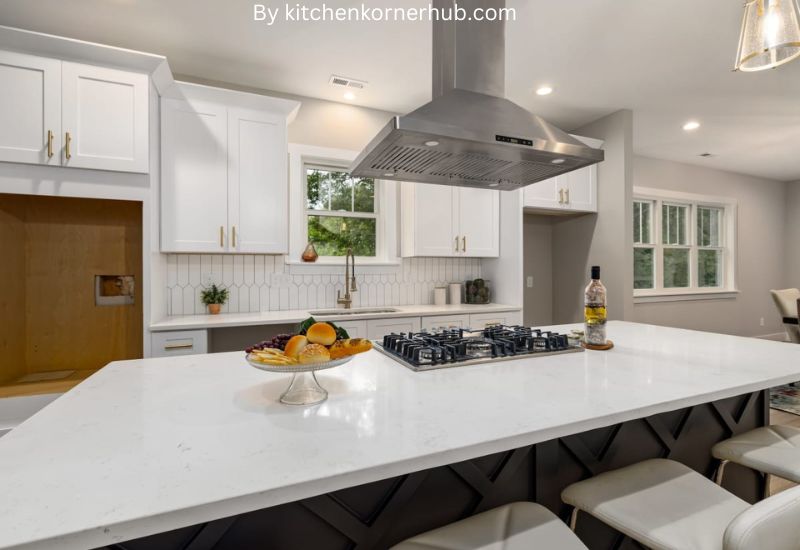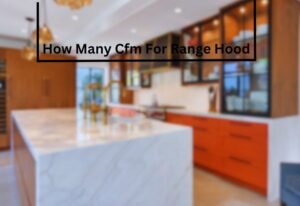When it comes to kitchen appliances, size matters. One common debate in the world of kitchen design revolves around the size of the range hood in relation to the cooktop. You might be wondering, can a range hood be smaller than the cooktop? It’s an important question because the range hood plays a crucial role in keeping your kitchen clean and smoke-free while you cook.
Can Range Hood Be Smaller Than Cooktop? Yes, a range hood can be smaller than the cooktop, but it’s important to ensure that it provides adequate ventilation. The size of the range hood should be based on the cooktop’s BTU output and the kitchen’s size. Smaller hoods are suitable for compact kitchens with lower cooking demands, while larger hoods are better for larger kitchens or high-heat cooking. Proper sizing ensures effective smoke and odor removal.
In this discussion, we’ll explore whether it’s possible to have a smaller range hood and still achieve effective ventilation. We’ll delve into the factors that influence the size of the range hood, such as the cooktop’s size and cooking habits. By the end, you’ll have a better understanding of how to strike the right balance between your range hood and cooktop for a well-functioning kitchen. Let’s get started!
“Exploring the Ideal Size Relationship: Range Hood vs. Cooktop”

In our quest for the perfect kitchen, we often overlook the importance of the size relationship between the range hood and cooktop.
Yet, this seemingly trivial aspect plays a vital role in ensuring an efficient and safe cooking environment. Let’s delve into this topic to better understand the ideal size relationship between these kitchen essentials.
The Crucial Role of a Range Hood
A range hood, also known as an extractor hood, is the unsung hero of your kitchen.
Its primary job is to remove smoke, odors, and grease particles from the air during cooking. However, to do this effectively, it must be properly sized in relation to your cooktop.
Balancing Airflow and Cooking Space
To strike the perfect size balance between your range hood and cooktop, you need to consider the airflow capacity of the hood.
The general rule of thumb is that the hood should be able to capture and expel the equivalent of your cooktop’s output. For instance, if you have a 30-inch cooktop, a range hood with a 300 CFM (cubic feet per minute) fan is usually sufficient.
Avoiding Overwhelm and Ineffectiveness
Going too big with your range hood may seem like a good idea for enhanced ventilation, but it can have adverse effects. An oversized hood can create excessive airflow, leading to inefficient capture and excessive noise.
In contrast, an undersized hood will struggle to keep up with the cooking emissions, rendering it ineffective.
Considering Cooktop Style and Usage
The type of cooktop you have also plays a role in determining the ideal size for your range hood. Gas cooktops produce more heat and emissions compared to electric or induction cooktops. Therefore, they typically require a more robust ventilation system.
Adapting to Your Kitchen Space
Your kitchen’s layout and available space should also influence your choice of range hood size. If you have a compact kitchen, consider a slim-profile hood that doesn’t overwhelm the space. On the other hand, a spacious kitchen can accommodate a larger hood for superior ventilation.
The Aesthetic Element
While functionality is key, the aesthetics of your kitchen should not be overlooked. A well-sized range hood can complement your kitchen’s design, becoming a stylish focal point rather than an eyesore.
“Space-Saving Solutions: The Case for Compact Range Hoods”

In today’s fast-paced world, where kitchen spaces are shrinking but culinary aspirations remain high, finding efficient solutions to maximize space is essential.
Among the many challenges, one often overlooked yet critical aspect is the range hood. In this note, we’ll explore the benefits and advantages of compact range hoods, shedding light on why they’re a must-have addition to your modern kitchen.
Efficient Ventilation for Small Spaces
Compact range hoods are designed with space in mind, making them perfect for kitchens with limited square footage.
Unlike their larger counterparts, these hoods are strategically engineered to effectively remove smoke, grease, and odors without occupying valuable space. Their compact size ensures they fit snugly above your stove while still providing efficient ventilation.
Aesthetically Pleasing Integration
One of the significant advantages of compact range hoods is their ability to seamlessly blend into your kitchen’s decor. These hoods come in various styles and finishes, allowing you to choose one that complements your kitchen’s overall aesthetics.
Whether you prefer a minimalist stainless steel design or a more discreet under-cabinet model, you can find a compact range hood that enhances your kitchen’s look.
Enhanced Safety and Comfort
Cooking can sometimes get messy, and a compact range hood plays a crucial role in maintaining a clean and safe cooking environment. By effectively capturing and venting cooking byproducts, such as grease and steam, these hoods prevent them from settling on surfaces and causing potential fire hazards or unpleasant odors.
This ensures a safer and more comfortable cooking experience.
Energy-Efficient Operation
Compact range hoods are not only space-saving but also energy-efficient. Many models come equipped with energy-efficient motors and LED lighting, reducing electricity consumption while still providing ample illumination over your cooking area.
This not only saves you money in the long run but also reduces your carbon footprint.
Easy Installation and Maintenance
Installing a compact range hood is a hassle-free process, making it an excellent choice for DIY enthusiasts. Most models are designed for straightforward installation and come with user-friendly instructions.
Additionally, their smaller size means that cleaning and maintenance are more accessible, ensuring your range hood continues to perform optimally.
Budget-Friendly Option
For those on a budget or looking to make cost-effective kitchen upgrades, compact range hoods are an attractive option. They offer the essential functionality of larger hoods at a fraction of the cost. This affordability allows you to invest in other kitchen improvements or appliances without breaking the bank.
Customizable Features
Many compact range hoods come with customizable features such as adjustable fan speeds and timers. This flexibility allows you to tailor the hood’s performance to your specific cooking needs, further enhancing its efficiency and effectiveness.
“Balancing Aesthetics and Functionality: Sizing Your Range Hood”

When it comes to designing your kitchen, one often-overlooked but critical aspect is choosing the right size for your range hood. This decision can greatly impact both the aesthetic appeal and functionality of your kitchen space.
In this note, we’ll explore the importance of finding the perfect balance between aesthetics and functionality when sizing your range hood.
The Heart of the Kitchen: The Range Hood’s Role
The range hood serves as the unsung hero of your kitchen, quietly but efficiently whisking away odors, grease, and smoke produced during cooking. Beyond its functional purpose, it plays a crucial role in the overall look and feel of your kitchen. To strike the right balance, consider the size carefully.
Aesthetic Harmony: Matching the Range Hood to Your Kitchen
Your range hood should seamlessly integrate into your kitchen’s design. It should complement the style, color scheme, and overall aesthetics of the space. For a modern kitchen, sleek and minimalistic hoods might be ideal, while a more traditional kitchen may benefit from a classic, decorative hood.
Proportions Matter: Sizing for Your Cooking Area
Choosing the correct size means taking your cooking area into account. The hood should adequately cover the entire cooking surface, ensuring efficient ventilation. A rule of thumb is that the hood’s width should match the width of your cooktop or range.
Ceiling Height and Hood Placement
The height of your kitchen ceiling and the placement of your range hood matter. For higher ceilings, consider a chimney-style hood that draws the eye upward. Ensure that the hood is installed at an appropriate height above your cooking surface to optimize its functionality.
Ventilation Power: Functionality Matters
Functionality should never be sacrificed for aesthetics. It’s vital to select a range hood with adequate ventilation power to effectively remove cooking byproducts. Check the hood’s CFM (cubic feet per minute) rating to ensure it can handle your cooking needs.
Noise Levels: Balancing Comfort and Performance
Keep in mind that powerful range hoods can be noisy. Look for models with variable fan speeds and noise reduction features to strike a balance between efficient ventilation and a peaceful cooking environment.
Maintenance and Cleaning
Finally, consider the ease of maintenance and cleaning when selecting a range hood. Opt for materials and designs that are easy to wipe down and keep looking great, as a dirty or greasy hood can quickly detract from your kitchen’s overall appeal.
“Innovative Design Trends: Smaller Range Hoods for Modern Kitchens”

In today’s fast-paced world, our kitchens have evolved from mere cooking spaces to multifunctional hubs of activity. Modern kitchens are all about convenience, efficiency, and aesthetics.
One significant trend that has gained popularity is the use of smaller range hoods. These innovative design solutions are transforming the way we think about kitchen ventilation. Let’s delve into this exciting trend and explore its various aspects.
Sleek and Space-Saving Design:
Smaller range hoods are celebrated for their ability to fit seamlessly into compact kitchen layouts. Unlike their bulkier counterparts, they occupy less space and create a sleek and uncluttered appearance. This design trend aligns perfectly with the minimalist aesthetics of contemporary kitchens, making them visually appealing.
Improved Ventilation Efficiency:
Despite their compact size, smaller range hoods pack a punch when it comes to ventilation. Advancements in technology have enabled them to efficiently remove smoke, odors, and grease, ensuring a clean and comfortable cooking environment.
These hoods are engineered to deliver maximum performance with minimal intrusion.
Customization Options:
One of the most exciting aspects of smaller range hoods is their versatility. They offer a wide range of customization options, from materials and finishes to lighting and control mechanisms. This allows homeowners to tailor their range hoods to match their kitchen’s unique style and functionality requirements.
Integration with Smart Home Technology:
The integration of smart home technology is another trend that has been making waves in modern kitchen design. Smaller range hoods are no exception, as they can be seamlessly incorporated into smart home ecosystems. This enables users to control ventilation settings, monitor air quality, and receive maintenance alerts through their smartphones or voice assistants.
Energy Efficiency and Sustainability:
With a growing emphasis on sustainability, smaller range hoods are designed with energy efficiency in mind. Many models now come equipped with energy-saving features such as variable speed fans and LED lighting, reducing both energy consumption and environmental impact. This aligns with the eco-conscious mindset of many homeowners today.
Enhanced Acoustic Comfort:
Another noteworthy feature of smaller range hoods is their reduced noise levels. Advanced sound-dampening technologies ensure that cooking remains a peaceful experience, free from the distracting hum of a loud exhaust fan. This acoustic comfort factor enhances the overall kitchen ambiance.
Ease of Installation and Maintenance:
Lastly, smaller range hoods are celebrated for their ease of installation and maintenance. Their compact size and streamlined design make them simpler to install, even in kitchens with limited space. Additionally, cleaning and maintaining these hoods are straightforward, making them a practical choice for busy households.
“Performance Matters: Assessing the Efficiency of Small Range Hoods”

Introduction:
In our quest for a comfortable and efficient kitchen, we often overlook the importance of small range hoods. These compact kitchen appliances play a vital role in maintaining air quality by removing smoke, odors, and grease.
However, their effectiveness can vary greatly. In this note, we will delve into the significance of assessing the efficiency of small range hoods and understanding how they can improve our cooking experience.
Understanding Range Hood Efficiency:
Small range hoods are not one-size-fits-all devices. Their efficiency depends on several factors, including size, airflow capacity, and installation. To make an informed choice, it’s essential to comprehend these aspects.
Size Matters:
The size of your range hood should match the size of your cooking area. If it’s too small, it won’t effectively capture and remove pollutants. Conversely, an oversized hood can lead to excessive noise and reduced efficiency. Choosing the right size is crucial for optimal performance.
Airflow Capacity:
The airflow capacity of a range hood is measured in cubic feet per minute (CFM). Higher CFM values mean better performance in eliminating smoke and odors. When selecting a small range hood, consider your cooking habits. For light cooking, a lower CFM may suffice, but for high-intensity cooking, a higher CFM is necessary.
Proper Installation:
Even the most efficient range hood won’t work effectively if not installed correctly. Ensure that it is positioned at the right height above your cooktop and that the ductwork is appropriately sized and vented to the outside. Proper installation guarantees optimal performance.
Energy Efficiency:
Evaluating the energy efficiency of small range hoods is equally important. Look for models with energy-efficient features such as LED lighting and variable fan speeds. These not only reduce energy consumption but also contribute to a quieter and more eco-friendly kitchen environment.
Maintenance and Cleaning:
Regular maintenance and cleaning of your range hood are essential for long-term efficiency. Grease buildup can obstruct airflow and reduce its effectiveness. Keep filters clean and replace them as needed to maintain peak performance.
Conclusion
In conclusion, the size of a range hood can indeed be smaller than the cooktop, but it depends on various factors such as the cooking style and the kitchen’s layout. While a smaller hood may work for some situations, a larger hood can be more effective in capturing all the smoke, odors, and grease produced during cooking. It’s essential to strike a balance between aesthetics and functionality to ensure a well-ventilated and pleasant kitchen environment. So, when choosing a range hood, consider your cooking habits and kitchen space to make the best decision for your needs.
Frequently Asked Question(Can Range Hood Be Smaller Than Cooktop)
Can your range hood be smaller than the stove?
Yes, your range hood can indeed be smaller than the stove. While it’s common to have a range hood that matches the size of your stove or cooktop, it’s not a strict requirement. The key factor to consider when choosing the size of your range hood is its ability to effectively capture and remove cooking fumes, smoke, and odors.
A smaller hood may work well if it has a sufficient airflow capacity to handle the output of your stove. However, it’s essential to ensure that the hood covers the cooking area adequately to maximize its effectiveness.
Does range hood have to be same size as cooktop?
The size of the range hood doesn’t have to be the same as the cooktop, but it should ideally be as wide or wider than the cooktop to provide efficient ventilation. This ensures that the hood can effectively capture the rising cooking fumes and direct them away from your kitchen.
However, some flexibility exists, and you can choose a slightly smaller or larger hood based on your specific kitchen layout and ventilation needs. Just remember that a larger hood will generally offer better coverage and ventilation performance.
Can you use a 30 inch hood with a 36 inch range?
Using a 30-inch hood with a 36-inch range is possible, but it may not be the most efficient choice. A hood that is smaller than the cooktop might struggle to capture all the cooking byproducts effectively, leading to less efficient ventilation. It’s generally recommended to have a hood that matches or is slightly larger than the width of your range.
However, if you have space constraints or other limitations, you can use a smaller hood as long as it provides adequate ventilation for your cooking needs.
How big should a hood be over a stove?
The size of the hood over a stove should typically match the width of the stove or be slightly larger. This ensures that the hood can effectively capture and remove cooking fumes, smoke, and odors produced during cooking.
The general guideline is that the hood should cover the entire cooking area to maximize its efficiency. Keep in mind that factors like the type of cooking you do, the power of your stove, and the layout of your kitchen can influence the size and performance of the hood. It’s essential to choose a hood that suits your specific cooking habits and kitchen setup for optimal ventilation.




